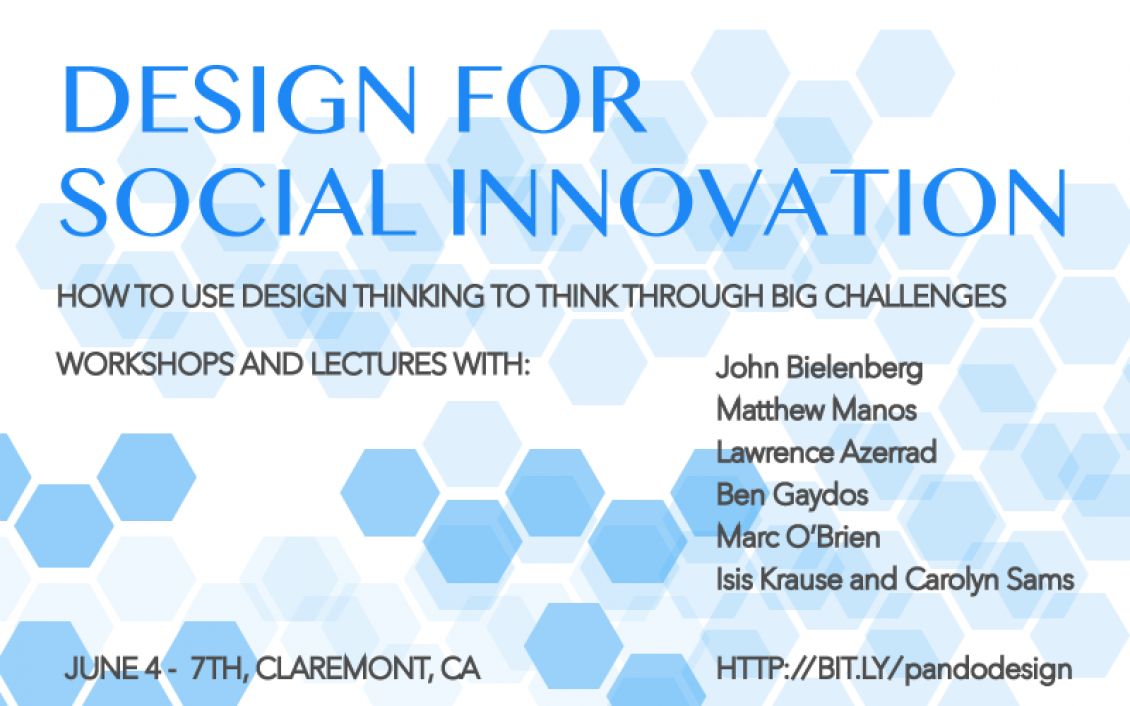Design Thinking
By Alex Molloy
Alex Molloy is organizing the conference Track titled, “Design for Social Innovation: How to Use Design Thinking to Think Through Big Challenges.” Track speakers include John Bielenberg (of Project M/Future), Matthew Manos (of verynice), Ben Gaydos (Professor of design at University of Michigan, Flint and goodgood), Marc O’Brien (Design Strategist and Creative Facilitator) and Isis Krause and Carolyn Sams (First Seating).
The conference’s “Design for Social Innovation” track focuses on the widespread and collaborative uses for design thinking for any field. I’ve organized this track as a mix of lectures and workshops lead by design thought leaders, who will describe their processes and put them into practice with small workshop groups.
Popularized by Tim Brown of IDEO, Brown describes design thinking as a “human-centered approach to innovation that draws from the designer’s toolkit to integrate the needs of people, the possibilities of technology, and the requirements for business success.”
To be clear, design thinking is not design. Rather it is a method of thinking through problems that designers use. It is a series of cognitive exercises that are used to inspire collaborative and creative thinking — a way in which to creatively turn a problem upside down and look at it in a different light.
It can be used to help you think through anything, from your marketing strategy to problem solving issues of carbon emissions, and anything in between. My notes below use the example of the California water crisis to see a few ways design thinking can help understand the problem and create better solutions.
- Understand your user/client/stakeholder.
Who are the stakeholders in terms of California water? Residents, farmers, and industry are the ones that usually get accounted for, but to think creatively about the stakeholders means to also take into account non-human life, the ecosphere, and future generations.
Understanding stakeholders is not as easy as it appears. Many stumble at this first step. To the extent that this conference is about rethinking fundamental assumptions, this is one thing that I take it to mean — that is, understanding your stakeholders and be willing to recognize that it includes a broader range and diversity than might comfortably fit.
- Define the problem you are going to solve.
After you have acknowledged your stakeholders — including their enormous diversity — and gotten to know their needs, you have a better sense of the real problem.
This is the step where you define the parameters. Is the problem that you will tackle in this exercise the lack of rain, groundwater depletion, or the water being too salty? You don’t need to bite off the entire issue (that is, the California water crisis), keep it small and manageable. You can always go back and work through another problem at a later point. Even so, it’s important always to keep in the mind the forest as well as the trees — which understanding the stakeholders (1, above) allows you to do.
- Ideate a bunch of possible solutions.
This is the part that sets design thinking apart from other methodologies, where you use cognitive exercises to bring about creative thinking. This is the fun part.
Perhaps it’s thinking of 100 solutions in 10 minutes. Or even “Thinking Wrong,” a process advocated by John Belienburg that seeks out the “wrong” solution in order to see a new perspective. (Join us Saturday at 10:00 a.m. for John’s talk on “Why ‘Thinking Wrong’ Will Change the World.”)
- Create a sample/prototype of the solution.
Think quick, easy, and small. Prototypes are (or can be, anyway) cheap. They needn’t have heavy ego investments, either.
Designers often use clay, paper, a 3D printer or even toothpicks to prototype this low-cost drill. You often don’t know what works until you can see it and try it.
- Test the prototype to see if it really solves the problem.
The question, of course, is does it work — faster/cheaper/more efficiently than the current solution? Does it solve the problem you set out to solve? And, most fundamentally, does it meet the needs of your stakeholders? Lots of “solutions” work in the abstract, and even meet a small subset of needs, but fail to meet the needs of a broad diversity of stakeholders (especially the ones that don’t have powerful voices).
In terms of the California water crisis, for instance, if stakeholders are only defined as, say, golfers, then any number of prototyped approaches to the crisis might work. But if human recreational needs are defined as only one kind of stakeholder interest from the outset — alongside, say, that of a healthy aquifer, as well as that of small, rare fish — then real solutions, while not so easy to spot, will more likely be connected to the whole of reality.
- Take this feedback and make it even better.
Rarely does anyone get it right the first time. So now is the time to take your great idea, iterate on it and test. And then iterate and test. And iterate and test until you get it right.
One of the main advantages of this method is that it encourages creative thinking and allows people to go through the entire process without becoming attached to one particular outcome. And in the process, it doesn’t allow anyone to put too much time and money into untested ideas.
Join us at “Design for Social Innovation: How to Use Design Thinking to Think Through Big Challenges” to hear from social impact designers and test out methods in small workshops that can prepare you to better think through some of the kinds of challenges you’re up against. Learn more and sign up at http://bit.ly/pandodesign.
